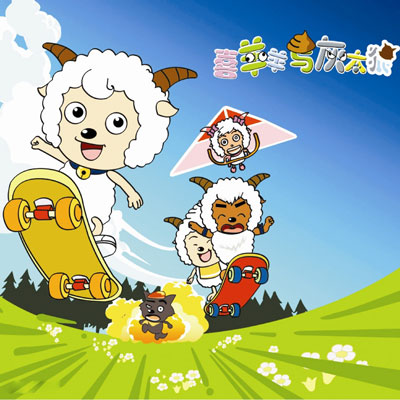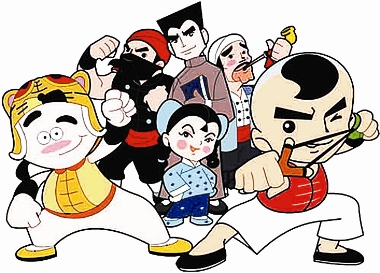

CHINESE cartoonist Liu Hong built her studio from scratch, doing postproduction work for TV commercials and then, after she broke even, realized her dream of creating cartoons for Chinese children.
Breaking into a market dominated by State media companies has been tough — even more so now that “Kungfu Panda” creator DreamWorks Animation SKG and other big cartoon giants are launching their own local studios in China.
Liu has had help. Seeking to nurture creative industries, the Shanghai government gave her the studio, Shanghai Cartoon Communication Group, a choice location. But its success so far mainly stems from its ability to balance cartoon making with sales of related products, she says.
Having drawn-in-China cartoons high on the national entertainment agenda helps Chinese creators: Prime time is reserved for domestic cartoons — no “Winnie the Pooh” or “Tom and Jerry” between 5-9 p.m. Also high on the country’s agenda is breaking into a huge global industry. China has yet to strike the magic formula that draws audiences across borders and age groups.
“China’s cultural influence has not matched its economic growth and officials here want to spread Chinese culture abroad,” said Sun Shaoyi, a professor of film and television at Shanghai University.
The recent slew of alliances between industry giants such as DreamWorks and the Walt Disney Co., which is building a theme park in Shanghai, will bring in new technology and help improve local industry standards, says Liu, whose studio has worked on foreign projects for years.
But such collaboration has its limits, she says, because cartoons that work in the United States might not be popular over well in China, especially among adults.
“In some cases, the kids really like it, but TV stations say they are unacceptable,” Liu says. While American schools and families might encourage children to think for themselves, “in China, it’s all about obeying the teachers.”
Shanghai animation saw its heyday in the 1960s, before the 1966-76 Cultural Revolution.
China now has 2,400 schools providing animation training.
But generally China is not really doing enough to support homegrown animation, Liu says, especially smaller studios such as hers, which employs about 200 people in Shanghai and another studio in the nearby city of Wuxi.
“To shift from quantity to quality is now the biggest challenge for Chinese cartoon makers,” she says. “There’s also the problem of piracy. It doesn’t do any good to have favorable policies if you don’t protect the commercial strength of the producers.”
DreamWorks’ US$330 million new venture with China Media Capital, State-run Shanghai Media Group and Shanghai Alliance Investment — christened Oriental DreamWorks — will make animated and live action movies for the Chinese and world markets while developing related businesses such as products, interactive games and theme parks.
Walt Disney’s Marvel Studios recently announced plans to coproduce “Iron Man 3” in China with DMG Entertainment of Beijing. Disney has joined with Internet company Tencent Holdings Ltd. and the Ministry of Culture to develop the animation industry.
Whether a Chinese cartoon icon to match the likes of Mickey Mouse will emerge from such alliances is unclear. The obvious lure for foreign companies is China’s fast, huge and growing market.
A highly anticipated version of the classic “Monkey King: Uproar in Heaven” in 3D, turned out by a Shanghai State-run animation studio linked to giant Shanghai Media Group, took in only about US$8 million.
The biggest Chinese-made cartoon hit was a sequel to the popular TV program and movie, “Pleasant Goat and the Big Big Wolf,” a Roadrunnerlike tale of clever lambs outwitting hapless wolves.
The cartoon’s producer, Creative Power Entertaining LLC, based in southern China’s Guangdong Province, says it grossed US$20.6 million. But “Kungfu Panda 2” grossed nearly US$100 million.
China’s roughly 10,000 animation studios, employing 200,000 people, churned out 260,000 minutes of animation material in 2011 — about half a year’s worth of continuous programing. Most of it will never be broadcast.
With supply far exceeding demand, about nine in 10 animation companies are unprofitable, State media report, citing industry insiders. To get by, most studios rely on overseas outsourcing contracts and deals with toy manufacturers and other companies using cartoon figures for advertising.
Though big projects like Oriental DreamWorks may pose a challenge for smaller Chinese studios, Shanghai Cartoon is stronger thanks to its postproduction business and sales of cartoon-related books, DVDs and toys, says Liu, who went back to school to hone her business skills with an MBA a few years ago.
Her company has turned out about 10 cartoon movies, including “Kuaile Xinxin,” or “Happy Sweetie,” comic stories about a little girl aimed at 2- to 5-year-olds that won top prize for excellent animation from the State Administration of Radio, Film and Television last year.
Despite the challenges, “We are in a good period,” Liu says.
“Every year, 20 million children are born here,” she says. “Thanks to the one-child policy, each child tends to have six adults spending money on them, so the environment is very good.”(SD-Agencies)
|

